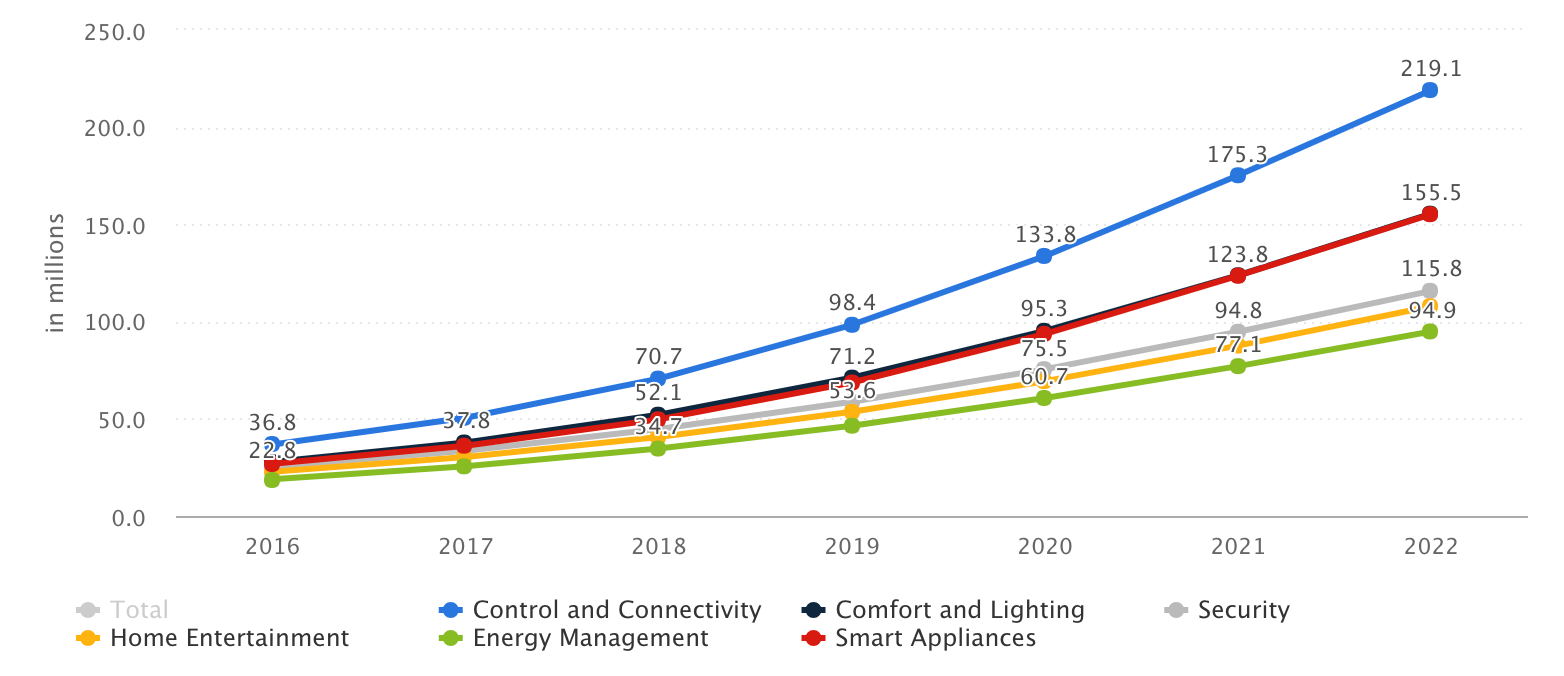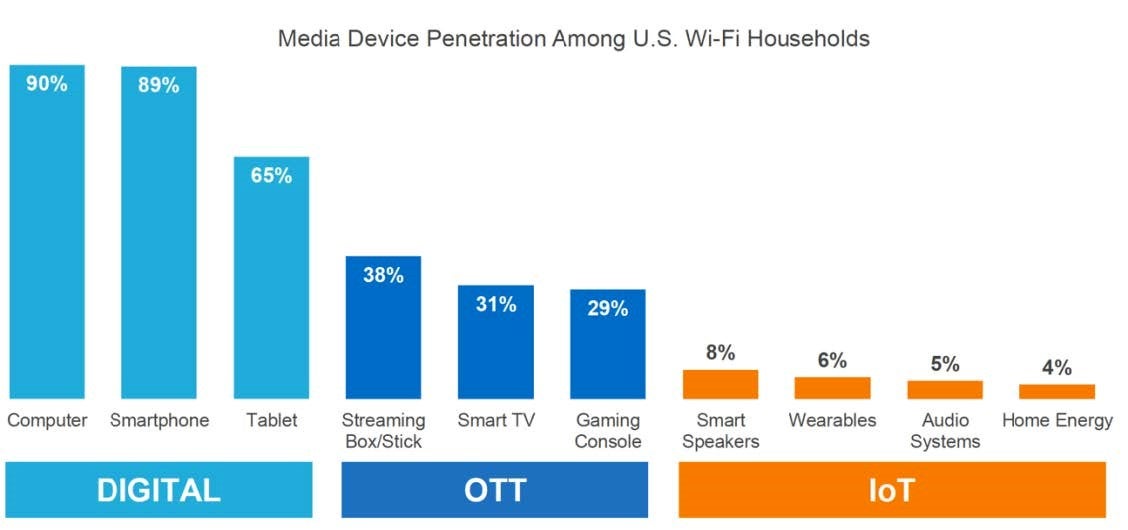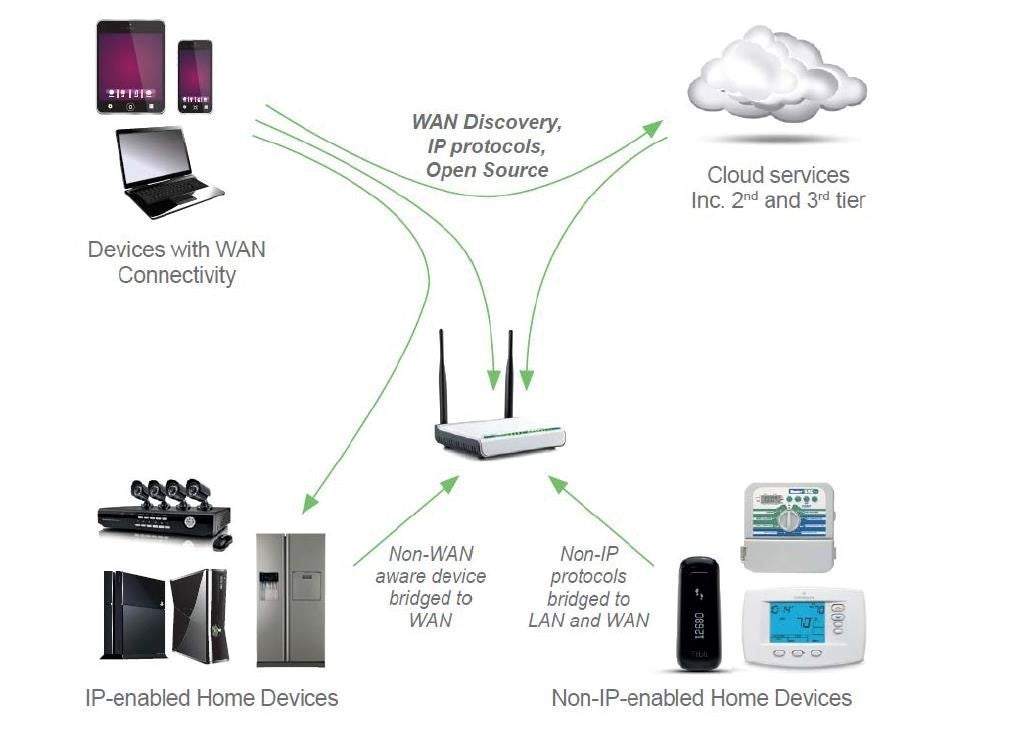Towards the Connected Smart Home
In recent years, the connected ‘smart home’ has become the battleground for device manufacturers, network suppliers, and service providers, all wanting a piece of the action. In the traditionally controlled home space, service providers are under attack by the entry of OTT suppliers such as Google, Amazon, and Apple. They need to react or otherwise be forced to remain ‘dumb pipe’ providers.
For operators, adaptive Wi-Fi is the first step towards converting the connected home into a smart home, by delivering a modern smart home system that is cloud-based, highly scalable, cognitive, and allows for the use of data to create new applications and services.
More Applications, Devices, and Connections
While, at the moment, the average number of connected devices in the home is estimated to range from 7 to 10 (depending on the region), the trend is clearly moving toward an increase to 20, 30, or even 50 devices per home in the next few years. All major categories of smart home device shipments worldwide are dramatically increasing, as presented in the Statista projections below.

Most of these devices have some form of wireless connection to them. The wireless footprint of these devices varies considerably and is a recipe for a rocky Wi-Fi experience, unless some order is established in this chaotic space. For example, a great number of devices only support the 2.4 GHz Wi-Fi band, making band steering even more essential for the devices that support dual-band Wi-Fi; to avoid congestion. Among the devices that support dual band, many never connect to 5 GHz, while a high percentage also experience coverage issues with 5 GHz.
Currently, few homes have high performance radios or proper coverage through extenders, leading to many users experiencing coverage and/or performance issues. This is common and affects the service provider’s bottom line because, regardless of whether it is a managed gateway or a third-party device, residential users will blame their broadband providers for their connection issues.
Not only is the number of connected devices in the home rising, but the proportion of high capacity devices, such as VR and 4K TVs, is also growing. As shown in the figure below, devices requiring high bandwidth and driving multi-AP growth are growing in popularity. According to some estimates, in several years there will be potentially 17-20 major Wi-Fi devices in the home that consume large amounts of bandwidth, excluding low bit-rate Wi-Fi IoT connected devices. These trends will further reinforce the need for a proper operator-managed home Wi-Fi environment to ensure quality of experience.

Defining the connected home
We can define a smart home as a home that can deliver a number of digital services inside and outside the home, through a range of connected devices. While high-speed Internet connectivity is not centrally important for all devices within the home, the availability of a permanently accessible broadband connection ensures the full functionality of a smart home.
The rise of voice assistants
Throughout 2017-2018, the most important advance in the smart home has been the emergence of voice assistants. The importance of this new development cannot be overemphasized, as voice assistants have become the dominant modality for many users’ control of their smart homes.
The growing importance of these voice assistants defines the smart home market of today. Specifically, huge opportunities arise for systems that can integrate with these voice assistants.
Towards a smart home set
In the past, most smart home vendors have focused on a specific item, or a range of items, such as smart doorbells or thermostats, in the market. However, now a more complete smart home set should be offered to consumers. Therefore, vendors will have to integrate into their systems the devices from other vendors or turn to manufacturers to plug the gaps in model line-ups. With the growing market presence of vendors such as Amazon and Alphabet (Google), this trend will only expand and develop, forcing traditional vendors to adapt their products accordingly.
Wi-Fi as the foundation for the connected home
One of the key requirements that the industry has to ensure is reliable interoperability. Indeed, consumers expect that any new device they purchase will seamlessly integrate with what they already have. In view of the growing customer demand for the ease of use, inter-device compatibility, and transparent guidelines throughout the buying process, the industry has to embrace the concept of the connected home as a single and cohesive market entity. Given the established presence of Wi-Fi and Wi-Fi-enabled devices in the home, Wi-Fi should play a central role as the glue to connect and manage most of the IoT devices.
A hub to manage all the IoT
Every day, new connected devices and sensors are hitting the market. Average homeowners are frequently frustrated and confused by the lack of universal integration arising from many connected devices and sensors’ use of proprietary connectivity protocols and radios or their reliance on non-IP based communications or wireless technologies.
Regardless of the degree of innovation of a particular product or technology, any interaction is difficult, if not impossible, unless it can effectively communicate with other devices in the home and does not require a specific application required for its control or monitoring. Usually, manufacturer-specific, even open industry standards, lock a user into a specific vendor or product line, as such products are not compatible with all other IP-based devices within the home network (as shown in Figure 3). In this context, a simpler, standardized, and universal solution is needed.

Conclusion
For operators, adaptive Wi-Fi is just of the requirements needed to deliver a modern smart home system that is cloud-based, highly scalable, cognitive, and allows for the use of data to create new applications and services sufficiently well and fast to outpace Amazon, Google, and Apple.
Along with the smart home platform, cognitive Wi-Fi will enable subscribers to onboard, configure, and secure IoT devices, such as cameras, in millions of homes with common middleware. The vision is to implement machine learning and prevent intrusion and malice activity in the home network.
Related Articles




